
by Rick O'Connor | Nov 22, 2013
It seems everyone in the Panhandle is talking about the invasive lionfish. This non-native member of the scorpionfish family was first seen in U.S. waters in 1989 near Ft. Lauderdale. Over the last two decades, much has been learned about the biology and potential impacts of lionfish in our waters; For additional background information you can read more at these websites http://myfwc.com/wildlifehabitats/nonnatives/marine-species/lionfish and http://escambia.ifas.ufl.edu/marine/2012/08/17/the-invasion-of-the-lionfish
This past October, the Florida Fish and Wildlife Conservation Commission held the first state lionfish summit in Cocoa Beach. Researchers, fishery managers, divers, fishermen, and the general public received research updates, discussed current issues, and provided input regarding future management needs. Here are a few of the interesting highlights from the summit.
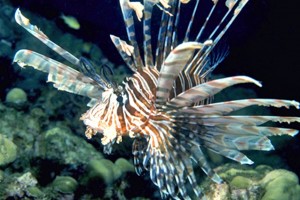
Red Lionfish
Photo: Florida Sea Grant
What are the potential problems?
- Several theories on how lionfish were initial released into state waters have been suggested. However, research results now indicate a single introduction of lionfish in Florida initiated the invasion into the Western Atlantic presumably from just a few aquarium specimens.
- Sixty-thousand lionfish continue to be imported into the state each year.
- Compared to native Pacific population, Florida densities of lionfish are much higher; 400 fish/hectare in Florida compared to 80 fish/hectare in the Pacific. On average, invasive Atlantic Lionfish individuals are larger than the native populations in the Pacific basin.
- Studies from Pensacola showed that lionfish population has doubled annually since 2010 and lionfish densities are highest on artificial reefs.
- Invasive lionfish have no natural predators and may spawn 30,000 – 40,000 eggs every 2 to 4 days.
- Another potential problem reported are records of lionfish entering the Loxahatchee and Indian Rivers; indicating that they are able to move into brackish water.
What are the negative impacts?
Young lionfish feed primarily on crustaceans and when they are older they prey on reef fish. Research and stomach analysis indicate 70 different reef fish species as potential prey. Lobster fishermen in the Keys found lionfish are the leading by-catch species and have reduced lobster harvest by as much as 50%. Another study indicates lionfish on natural reefs they prefer blennies. However, on artificial reefs they feed on small snappers, sea bass, and groupers. Finally, an interesting study compared primary reef predators. Reefs with only grouper there was a 36% decrease of juvenile fish while reefs with lionfish the decrease was 94%.
What can be done?
Several reports indicate that collecting tournaments are effective; Lad Akins of Reef Environmental Education Foundation (www.reef.org) reported a 69% reduction of lionfish from one event in Key Largo. Another study had similar results but indicated that some spear fishermen were more successful than others, suggesting training may be required to increase efficiency.
Other reports indicate that work where native fish were introduced and conditioned to consume lionfish have led these native predators to follow and even bite divers thinking that “free food” may be available; it was suggested that this idea not be pursued.
Locally, lionfish rodeos sponsored by Emerald Coast Reef Association occur frequently in Okaloosa County. Escambia County Marine Resources hosted a pilot event this summer. Escambia will begin a full lionfish control program in 2014. If you have questions or comments, please contact your local UF/IFAS natural resource or Sea Grant Extension Agent.
Please note: UF/IFAS and Florida Sea Grant does not organize volunteers to participate in local lionfish control events; this is done by independent community groups. UF/IFAS and Florida Sea Grant provides this information about food safety concerns associated with eating lionfish. Click here for more information.
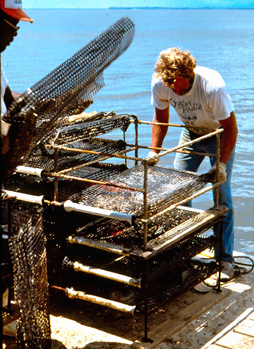
by Bill Mahan | Jul 25, 2013

Extensive methods of oyster farming have been promoted in various forms and under changing laws for over 100 years in Florida. (UF/IFAS photo)
What: A Conversation About Oyster Aquaculture
When: Monday, July 29, 2013, 2 to 5 p.m.
Where: Community Center, Apalachicola (Ten Foot Hole)
Seeking insights into the pros and cons of growing oysters, Apalachicola’s commercial oyster industry has asked members of the University of Florida Oyster Recovery Team to a question-and-answer discussion on Monday, July 29, 2013, from 2 to 5 p.m. in the Apalachicola Community Center. The program is open to the public.
Recent changes in state rules governing shellfish aquaculture in Franklin County have stimulated new discussions about growing oysters to supplement the traditional, wild-caught harvest, according to Karl Havens, director of Florida Sea Grant and the leader of the UF oyster recovery team.
While it is too soon to know if those changes will translate into financial success, culturing oysters remains a demanding and relatively unproven business, Havens said.
“The members of the UF team with expertise in aquaculture methods and economics will answer questions about all aspects of its feasibility.”
In June, the Florida Cabinet modified state regulations to allow owners of two existing oyster aquaculture leases in Franklin County to locate growing cages up off the bottom and into the full water column. The experimental technique applies to just two existing aquaculture leases of 1.5 acres each in Alligator Harbor, near St. Teresa Beach.
Apalachicola Bay’s commercial oyster fishery is trying to recover after extended droughts in 2011 and 2012 dramatically decreased one of the nation’s most productive fisheries. The UF recovery team recommended a long-term plan for future monitoring, research and management to restore the Bay’s oyster populations to historic levels.
The team also recommended a large-scale restoration of the bay’s degraded oyster reefs as a top priority to accelerate oyster recovery.
The meeting is hosted by SMARRT, the Seafood Management Assistance Resource and Recovery Team. There will be no formal presentations, just informal questions and answers.
by Rick O'Connor | Mar 13, 2013
Those who have lived in the Panhandle area for many years will remember the days when our local bayous were places people water skied, kids learned to swim, and fishermen brought home plenty of speckled trout. But today we see little of this. Water quality within our bayous has declined to a point that the general public is concerned about recreation within them and most use them as access to larger bodies of water where they can enjoy water activities.
What Happened?

The mouth of Bayou Grande near Navy Point; a popular recreation location
Those who lived here when things were better say they first noticed problems when new roads and subdivisions were built in the 1950’s. Decline in water clarity was one of the first things they noticed. This was followed by a loss of submerged grasses, fish kills, and an increase in health advisories due to high levels of bacteria. These new subdivisions cleared much of the native vegetation in the neighborhoods and along the water front. The loss of vegetation and new roads allowed for more runoff to reach the bayous. Much of this runoff was in the form of leaf litter, twigs, animal waste, and maybe even carcasses of dead creatures. Once reaching the water these organics are broken down by bacteria into forms of nitrogen and phosphorus that can be utilized by aquatic plants and phytoplankton. This increase in plants will produce more oxygen, but they also consume oxygen in the evening. The high demand for oxygen in the evening can cause dissolved oxygen levels to decline to a point where aquatic life begins stressing; we now say the water is hypoxic. To add to the problem people began to have the desire for lawns of non-native grasses which require fertilizer and watering; thus increasing the nutrient load on the system and an increase in hypoxia. This eutrophication process was a major contributor to the fish kills that the bayous were experiencing.
In addition to nutrients, animal waste could be found in the stormwater. Animal waste can contain pathogens that could be a serious risk to public health. Scientists monitor the concentration of these pathogenic bacteria by using a group of indicator bacteria called fecal coliform bacteria. High levels of these fecal coliforms indicate that a potential health risk could be present and the Escambia County Health Department would issue a health advisory for that body of water. A study showed that the concentration of fecal coliforms increased in areas where coastal development increased, connecting them to stormwater problems.
So What Can We Do?

Marine Science Academy students from Washington High School measuring chlorophyll in Bayou Texar; photo: Ed Bauer
We will probably never be able to get the bayous back to the state they were in before the development boom of the mid-20th century but there are few things we can do.
First, the reason the nutrients and fecal coliforms increased was an increase in runoff. This increase was due to road construction and loss of vegetation. We cannot do much about the roads but we can rethink how we landscape our yards and waterfront property.
The Florida Friendly Yards Program is one that helps residents with selecting plants and landscaping features that require little or no fertilizer or water. This not only reduces the runoff but saves the homeowner money. Rain barrels and rain gardens are also methods that can both reduce water runoff and save money. For more information on this program you can contact Carrie Stevenson at the Escambia County Extension Office; 850-475-5230 or ctsteven@ufl.edu.
Shoreline vegetation can be restored through the Living Shoreline Program. In this program the Florida Department of Environmental Protection works with the homeowner on designing a shoreline marsh and/or oyster reef project. Living Shorelines utilize plants that remove much of the nutrients found in runoff and oysters are known to filter 50 gallons of water per day, reducing turbidity typically caused by runoff. Not only do Living Shorelines reduce nutrient runoff, they also reduce erosion caused by wave energy. For more information on Living Shorelines contact Beth Fugate at beth.l.fugate@dep.state.fl.us.

Planting a Living Shoreline on Bayou Texar in Pensacola; photo: Florida Department of Environmental Protection
A third program that can help bring back the bayou is the Clean Marina / Vessel Program. This program is through the Florida Department of Environmental Protection. For more information contact Jeanne Williams at Jeanne.Williams@dep.state.fl.us.
We hope you will consider using one of these programs to help improve the water quality within our bayous. If you are interested in having a presentation on these programs contact Rick O’Connor at the Escambia County Extension Office; 850-475-5230 or roc1@ufl.edu.
by Brooke Saari | Mar 8, 2013
National Invasive Species Awareness Week: March 3rd – March 8th
March 8th: Red Imported Fire Ant (Solenopsis invicta Buren) & Giant Tiger Prawn (Penaeus monodon):
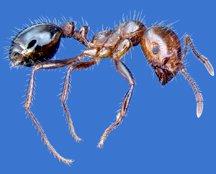
Photo Credit: David Almquist, University of Florida
Red Imported Fire Ant: Many of us cherish childhood memories of family picnics during summer. What we likely also remember are the surprise guests that arrive to take away any crumbs we happen to drop their way. Ants are a common site in almost any yard or farm in Florida. Homeowners and farmers spend time and money trying to rid their landscapes of the pests. Red imported fire ants (RIFA) are a species first introduced into the United States in our local area through the port of Mobile. These ants have now spread to states as far west as California and north to Maryland. Red or brown in body color, they build large nests with soil above the ground. Any disturbance of the mound brings thousands of angry ants to find the intruder. Ants have a short lifecycle and lifespan. Eggs usually hatch in 22-38 days and workers live no longer than 6 months. Queens can live to 6 years, however. RIFA’s forage on dead animals and home food wastes. Garbage and food left around the home can attract ants into dwellings. Mounds are common around or under structures, moving to higher ground during rainy weather. RIFA’s can also damage crops and cause equipment damage with large enough infestations. Management for these pests can be accomplished in two ways: through individual mound treatments or through broadcast treatments. Individual recommendations can be found here, http://edis.ifas.ufl.edu/in352. Whatever method of treatment you choose, make sure to follow proper label recommendations on products. Care should be given to areas where children, pets, and livestock have access to avoid ingestion of treatments chemicals.
For more information, contact the author Allison Meharg, 4-H Livestock & Small Farms Agent 850-475-5230.
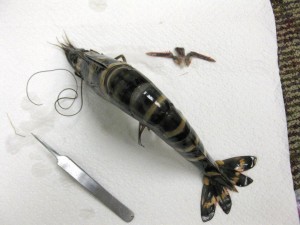
Photo Credit: FWC photo by Michelle Sempsrott
Giant Tiger Prawn: This large shrimp, also known as the Asian Tiger Shrimp and the Black Tiger Shrimp, can reach lengths between 8-12 inches. It resembles are native edible penaeid shrimp but differs in that it has distinct black and yellow stripes. It was brought to the U.S. from the Indo-Pacific region as an aquaculture product. There was an accidental release of 2,000 animals from a South Carolina farm in 1988. Reports of this shrimp in the wild have increased over time. They have been found in all Gulf coast states and there has been at least 1 record in each of the Florida panhandle counties. The impact of this shrimp to our area is still unknown but they have a high tolerance for salinity change and consume many types of benthic invertebrates. It is thought that they could become serious competition for our native penaeid shrimp and could possible transmit diseases. If you think you have found one of these shrimp, record size location (GPS preferred) and email information to ExoticReports@MyFWC.com. To learn more about this species view the USGS factsheet.
For more information, contact the author Rick O’Connor, Sea Grant/Marine Sciences Agent 850-475-5230.
by Brooke Saari | Mar 3, 2013
National Invasive Species Awareness Week: March 3rd – March 8th
March 3rd: Tropical Soda Apple (Solanum viarum) & Lionfish (Pterois volitans):
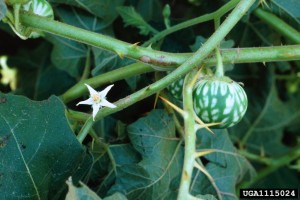
Tropical Soda Apple Photo Credit: Jeffrey Mullahey, UF, Bugwood.org
Tropical Soda Apple: Florida ranchers know Tropical Soda Apple (TSA) as the “Plant from Hell.” It was first noticed in south Florida, but its seeds survive in the digestive tracts of animals and it spread north through the movement of hay and cattle. TSA plants are covered with thorns and can make large sections of pasture nearly useless for livestock. Concerted efforts to lessen the population of TSA since its arrival have reduced the populations in pastures but it persists in sheltered or waste locations. Cattle, birds, deer and feral hogs ingest the mature fruits and spread the plants to loafing and browsing areas that may be inaccessible to mechanical treatment with anything larger than a hoe. According to Dr. Jeff Mullahey, who has been working on TSA since its appearance in south Florida, one plant can produce 40,000-50,000 seeds with seed germination ranging from 75%-100%. The seeds remain viable for at least three years. Be on the lookout for these while engaged in outdoor activities.
Isolated plants can be controlled by mechanical means. You won’t want to pull them up barehanded, though. Additional information and control methods are available at http://edis.ifas.ufl.edu/uw097, or contact your local Extension agent.
For more information contact the author Jed Dillard, Livestock & Forages Extension Agent by phone at 850-342-0187 .
.
Lionfish: The Red Lionfish is a non-native invasive predatory reef fish that has spread throughout Florida waters. Lionfish are members of the family Scorpaenidae; all members are venomous and the lionfish is no exception. This fish is relatively small, typically ranging from 12-15 inches in length with a zebra-like appearance and long, showy pectoral fins. They have a row of long, dorsal spines that contain venom glands. Their native range is the South Pacific and Indian Oceans and preferred habitat is on offshore reef structures. These fish are considered to be voracious eaters feeding on native fish, reducing vital native populations, and competing for food with native fish such as grouper and snapper.

Lionfish, Photo Credit: Rebekah D. Wallace, UGA, Bugwood.org
With few predators, these fish are thriving in Florida waters, even in the northern Gulf of Mexico. They reproduce often, sometimes all year, with their eggs hatching after about two days. They also consume a variety of local species, causing 80% decline in reef fish recruitment and loss of some economically important species. These fish are able to expand their stomachs for large meals and can survive starvation for over 12 weeks. These fish are an invasive species in our local waters and removal is encouraged. The most effective control of this species is removal by human. These fish are cryptic and nocturnal so locating them can be tricky. Spearfishing is the method of choice, since lionfish rarely bite a hook and line. Florida Fish and Wildlife Commission (FWC) changed regulations to increase harvesting opportunities. Such changes include no requirement for a recreational fishing license when using spearing devices (pole spear, a Hawaiian Sling, handheld net, or spearing devices marked for use on lionfish), and no recreational or commercial bag limit, though recreational fishing license is required for other fishing methods. Check the FWC regulations before fishing or diving for these species.
Lionfish are venomous and must be handled carefully. Venom glands occur on the dorsal, pelvic and anal spines. Lionfish sightings should be reported at 877.786.7267 . If stung seek medical attention as soon as possible. Rarely are stings fatal unless the person has an allergy to the venom. The Poison Help Hotline can be reached at 800.222.1222
. If stung seek medical attention as soon as possible. Rarely are stings fatal unless the person has an allergy to the venom. The Poison Help Hotline can be reached at 800.222.1222 . Sighting information is being collected to track the movement of these species. Fill out the online report on the USGS website or the REEF website. Stay up to date on research as it pertains to this species at www.flseagrant.org.
. Sighting information is being collected to track the movement of these species. Fill out the online report on the USGS website or the REEF website. Stay up to date on research as it pertains to this species at www.flseagrant.org.
For more information contact the author Brooke Saari, Sea Grant Marine Science Extension Agent, 850-689-5850
by Brooke Saari | Mar 1, 2013

National Invasive Species Awareness Week
Invasive Species Awareness: How is Your Invader Knowledge?
Invasive species are non-native or exotic species that do not naturally occur in an area and cause economic or environmental harm or harm to human health. These invasive species have become the number one threat to biodiversity on protected lands. However, invasive species do not know boundaries and as a result public and private lands are affected as well as natural and man-made water bodies and associated watersheds. Northwest Florida is home to many unique habitats, including upland, wetland, and marine. These habitats, housing a variety of plants and animals, make this area considered as one of the top six biodiversity hotspots in the country. These invasive species threats can come in the form of both plants and animals, in Florida there are over 500 non-native fish and wildlife species and over 1180 non-native plant species that have been documented. Exotic species are able to outcompete many natives causing habitats to degrade, animals to leave, and can introduce diseases that can destroy economically important species. This is a worldwide issue that can be addressed on local levels. One of the most effective ways to control invasive species is by prevention, just by becoming invasive aware can help to control some of these issues.
So how aware are you? Recreationalists such as boaters, fishermen, pet owners, gardeners, hikers and travelers can be unknowing dispersers of invasive species. These everyday steps can help: By cleaning and draining your boat, gear and trailer between water bodies can stop the spread of species that may be hitchhiking on your equipment. If you are a pet owner and find yourself in a possession of a pet you no longer want or can care for, it is important not to release these into the wild. No pet, either native or exotic, should ever be released. This act can cause more harm than good, not only to your pet but to the other native wildlife. Follow the simple tips on Habitattitude to get tips on alternatives to releasing your pet. When out enjoying nature while biking, hiking, camping, birding, etc. take care to check where you are trekking, what might have attached to your clothing, making sure you do not end up being an unwitting disperser. Gardeners, even you can help especially when dealing with non-native plant dispersal. Not all non-native plants are bad but make sure that the plants you are putting in your garden are not harmful invaders that will make it into natural areas. Verify your plants by making sure they do not occur on the invasive plant list which can be found at http://www.fleppc.org/. There are many ways to get involved in the battle against invasive species. For more information about National Invasive Species Awareness Week (NISAW) please visit http://www.nisaw.org/, landowners can join your local Cooperative Invasive Species Management Areas (CISMA) group or for more info on local invasive species contact your UF/IFAS extension office. Look for the invasive species of the day posts on the Panhandle Outdoors Extension Newsletter blog throughout NISAW to increase your awareness of local invasive exotic species.
For more information, please contact Brooke Saari, Florida Sea Grant Marine Science Agent, Okaloosa/Walton County UF/IFAS Extension by phone 689-5850 or email bsaari@ufl.edu.












